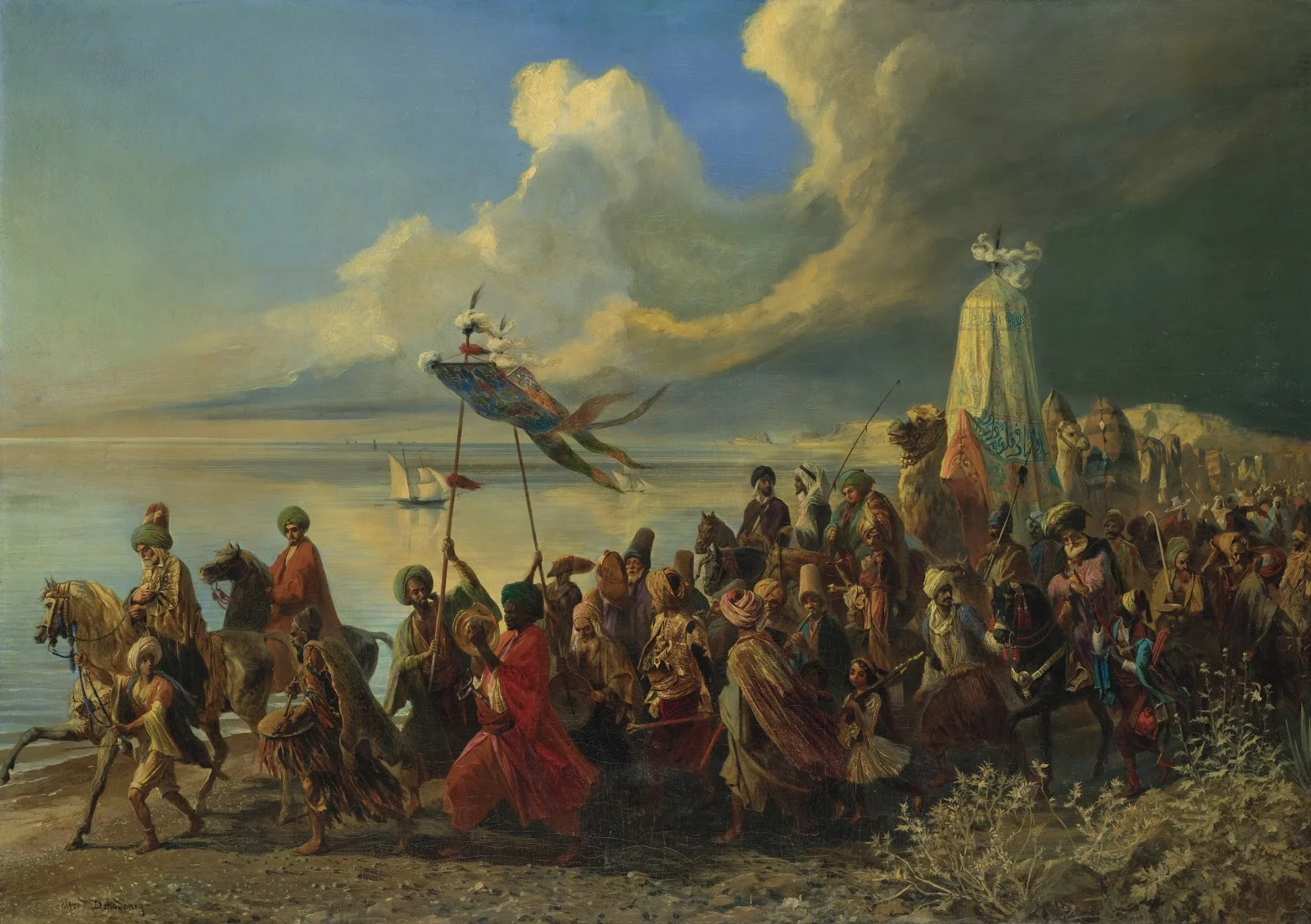For Muslims in the Russian Empire, the hajj to Mecca was always a dangerous undertaking, full of hardships from natural disasters and diseases to the risk of encountering con men and thieves. Pilgrims documented their hajj experiences in various languages in letters, diaries, and reports, which are now known as hajjnames or seyahatname. Today, we will tell you all about this difficult and perilous journey.
All Roads Lead to Mecca
Hajj, the Muslim pilgrimage to the sacred city of Mecca, is one of the five pillars of Islam. In the late nineteenth and early twentieth centuries, the practice of undertaking hajj became more widespread among the Muslims of the Russian Empire. Several factors contributed to this: improved welfare, better organization of routes, and, most importantly, the development of the railway system. Muslims from Turkestan—including those from the southern parts of Kazakhstan, the Volga region, and Semipalatinsk—began their hajj journeys by taking a train from Tashkent to Orenburg, Tula, and Moscow, eventually traveling to Odessa.
Thus, Odessa became a significant pilgrimage point for many Muslims of the empire, including the Kazakhs. Here, pilgrims needed to obtain a ‘visa’ to visit Istanbul and Mecca. However, as there was no established regulatory system for hajj, the process was often unclear.
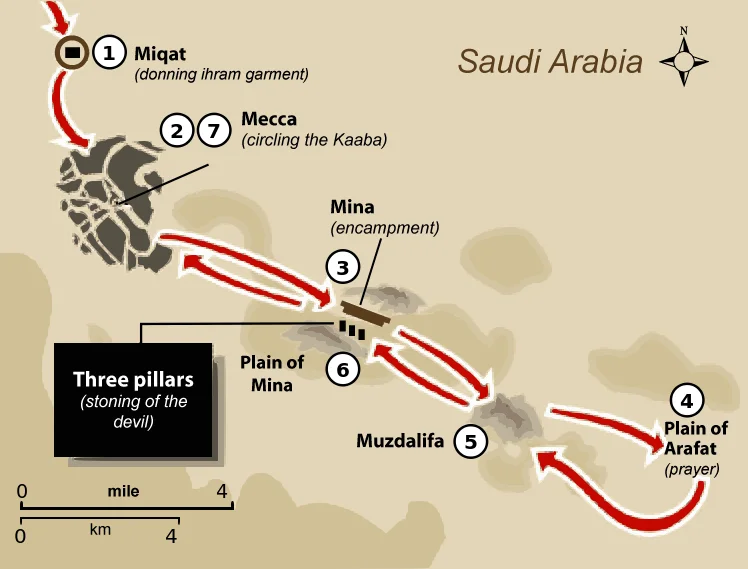
Hajj locations and rites/Wikimedia Commons
Some pilgrims relied on information from their acquaintances, while others hired guides who helped them purchase ferry tickets and find accommodation. From Odessa, pilgrims would typically continue their journey to Istanbul.
Istanbul was an important destination for many pilgrims, as it was here, in the city of the ‘caliph of all Muslims’ and the ‘Servant of the Two Holy Places’ (referring to the two holiest sites in Islam, the Grand Mosque Mecca and the Prophet's Mosque in Medina), that they could rest after a long, exhausting journey.
The city itself, with its numerous sacred sites, was an important place to visit. At the turn of the century, several new routes were established to reach the capital of the Ottoman Empire, with the route from Moscow playing a crucial role. Pilgrims could reach Istanbul in just six days by traveling from Moscow via Warsaw and Vienna. This route was especially convenient for those who preferred not to travel by sea and, of course, for those who could afford it, as the ticket cost nearly 100 rubles, which was a lot of money at that time.
Another route to Mecca was via Sevastopol, where a steamboat departed for Istanbul once a week. The travel time ranged from thirty hours to two days, depending on weather conditions. The ships were relatively small, and the journey was not the safest.

The holy caravan in the Ṣem - Caravan on its way to Mecca for the Hajj, after leaving Damascus. Soldiers and dignitaries with camel carrying the palanquin (Mahmal), the emblem of the Ottoman sultan, circa 1890/Alamy
Dispatches from the Hajj
Pilgrims setting off to complete the hajj recorded their experiences in many different forms, including letters, diaries, and travel journals, which are often referred to as hajjnames or seyahatname (meaning ‘records of the journey’ in several Turkic and Iranian languages). By the late nineteenth and early twentieth centuries, pilgrims were actively publishing their travel notes in multiple languages, including Arabic, Persian, and various Turkic languages. Some travelers would delegate the writing to more experienced individuals, who then conveyed their impressions of the pilgrimage. Kazakh pilgrims, too, left behind their own records of the hajj.
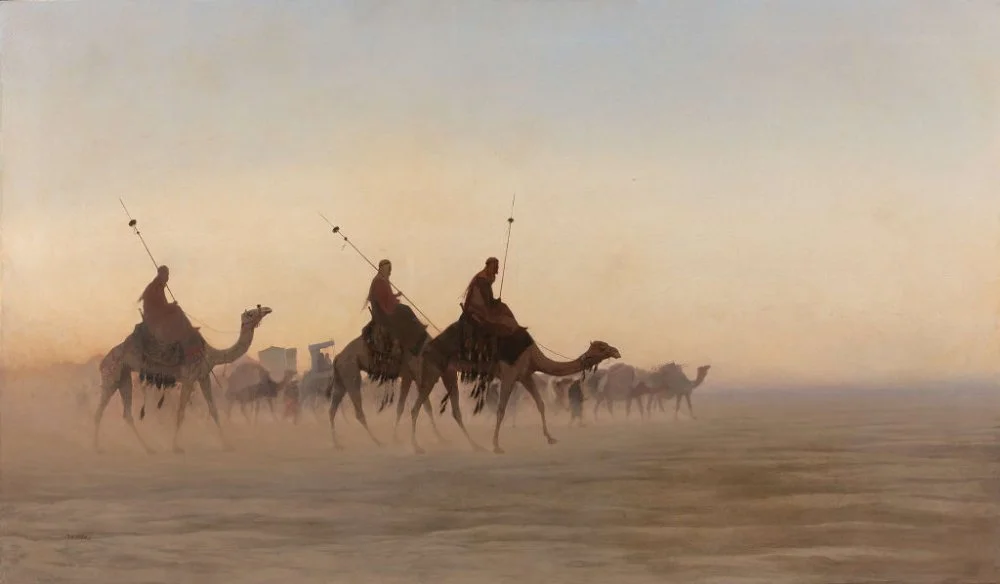
Frère Charles-Théodore. Great caravan of Mecca/Fine Art Images/Heritage Images via Getty Images
However, even with the advent of railways, the hajj remained a dangerous undertaking. Beyond natural disasters, technical difficulties, and various inconveniences, pilgrims were also at risk of falling victim to fraudsters. Travelers' spiritual intentions, ethnic and religious identities, or even their advanced age did not deter thieves and robbers.
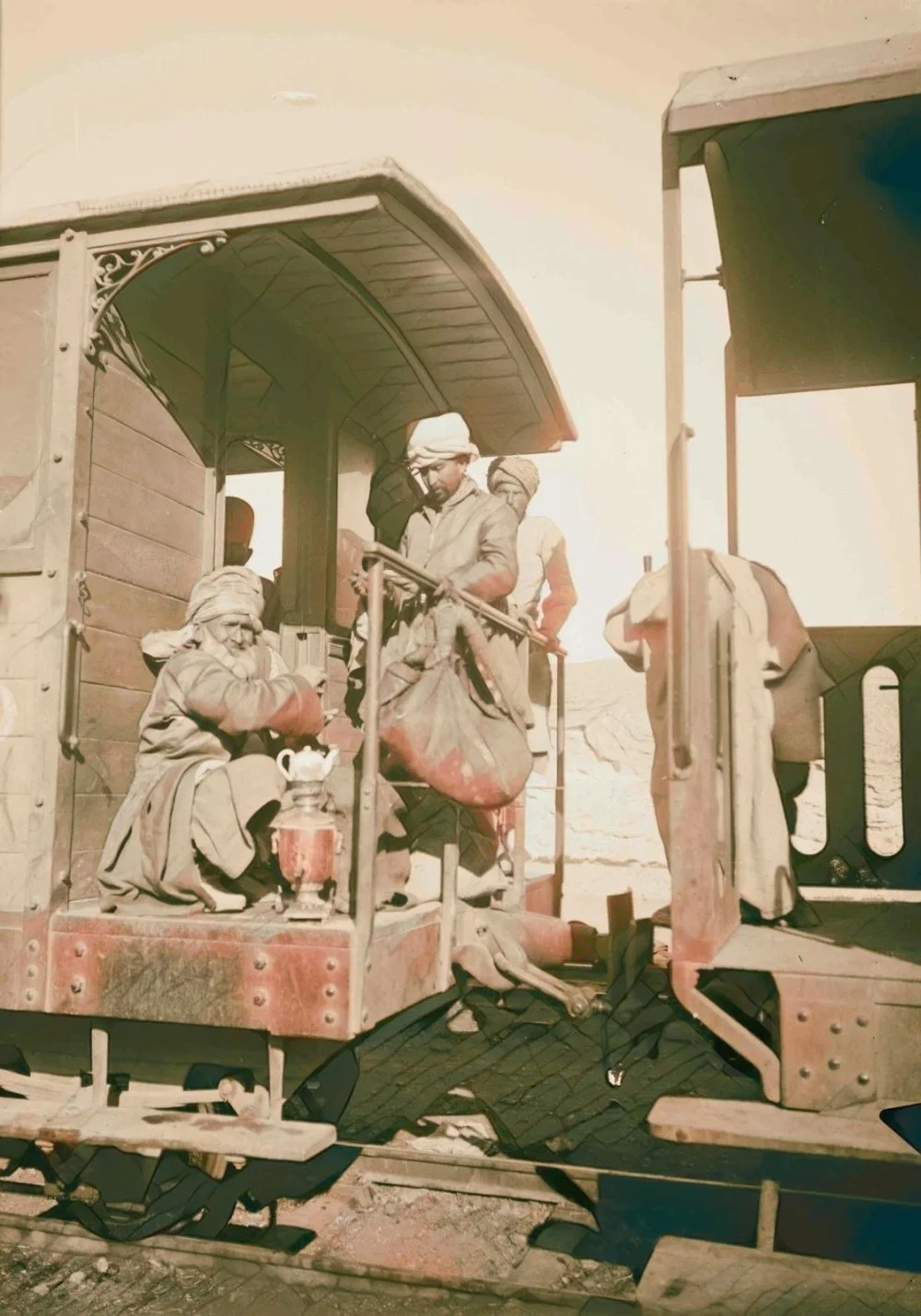
Muslim pilgrims on a train for Mecca 1900, Middle East. Reimagined by Gibon. Classic art with a modern twist reimagined/Alamy
To inform pilgrims about unforeseen dangers and help protect them from unpleasant situations, Gali Riza, an author from Kazan, published a guidebook titled A Guide for Hajjis, or a Story about How They Are Deceived in 1909. He wrote that upon ‘seeing the depressing state of fellow countrymen embarking on the pilgrimage’, he could no longer remain silent and decided to create the guidebook to save them from deception, writing:
‘Our naïve pilgrims are duped from the moment they leave their village and continue to be deceived until they return home. This is why pilgrims come back from the hajj in a bad mood.’
The guidebook provided exchange rates, ticket prices for trains and steamboats, as well as prices for visas, taxes, and local hotel rooms on all sections of the route. It also included advertisements—the author, for instance, highly praised a shop named Omar for its low prices and high-quality goods.
Interestingly, records of the journeys to Islamic holy places were not only maintained by ordinary Muslims in the Russian Empire but also by high-ranking military intelligence officers, such as Stabs-Kapitan Abdulaziz Davletshin, who documented his observations in Report of Stabs-Kapitan Davletshin on an Assignment to Hejaz, published in 1899. In it, he describes the luggage carried by the Muslims of the Russian Empire, including items like samovars, dried bread, pastilles, and dried berries. He notes that those with the most provisions were the Kazakhs, who also brought qurt, fatty sausages, and salted horse meat.

Zlatoust station was one of the stops on the Muslim pilgrimage route from Central Asia to Odessa. Photo by Prokudin-Gorsky. Early 1900s/Library of Congress
The relatives and loved ones of pilgrims often didn’t just help with provisions and money—they also had to guarantee the pilgrim’s return at their own expense in case of unforeseen circumstances. The following is an example of an official note of this nature, which was signed by an aul elder of the fourth rank, Abroi Kadyrbekovi
Issued by the Kazakhs (Kyrgyz) of the Semipalatinsk region, Pavlodarsk county, Altybaevsky district, fourth aul rank, to our fellow villager, Mergalim Janbulatov, stating that he is willing to undertake a journey to Mecca and Medina in the year 1888 to worship in the holy lands. It is also affirmed that he is of good character, has no criminal record, and has paid the tent duty and other necessary fees in full.
He has sufficient cattle, and, therefore, we have no objections to releasing him on leave to travel to Mecca and Medina to worship at the holy places. In the event that Janbulatov, for any reason, lacks the funds to return home, we, the undersigned, agree to provide the necessary funds for his return upon the first demand. This agreement is confirmed by the signatures of the literate and the tamgas of the illiterate.
The Hajjname of an Unknown Kazakh
For Kazakh pilgrims, hajjnames written in Kazakh served as similar, valuable sources of information. They were composed by pilgrims to help travelers navigate the expenses and prices of their journey from the Kazakh steppe to Mecca. An unknown author of one such hajjname published in 1893 refers to himself simply as a ‘pauper’, a term commonly used in religious literature to emphasize the author's humility and modesty.
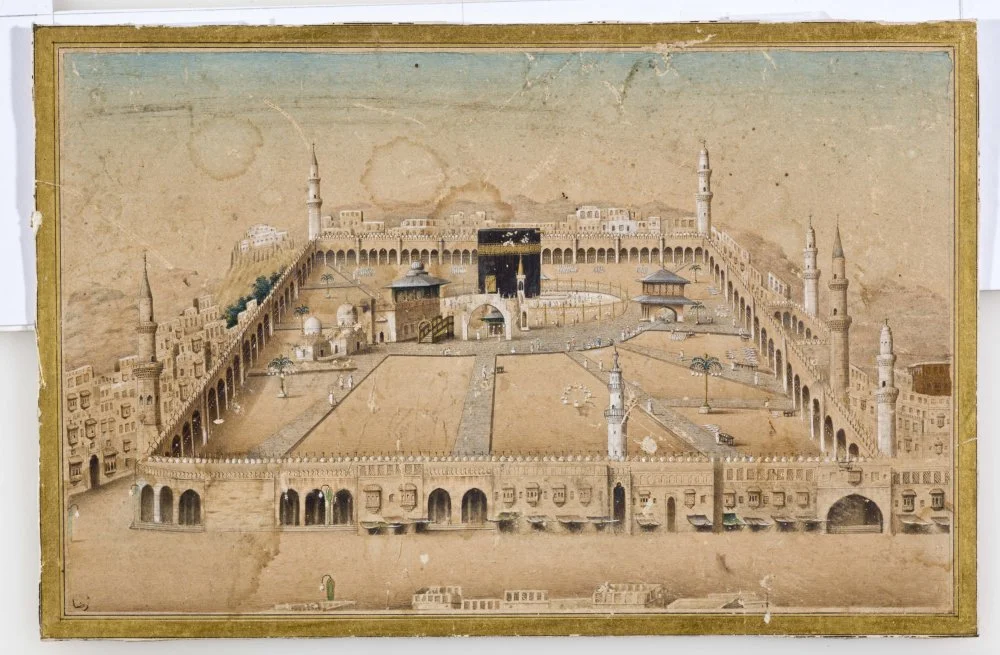
A Painting of the Holy Sanctuary at Mecca. 19 century/Wikimedia Commons
Throughout his account, he consistently writes in the plural, suggesting that he was not traveling alone, though he provides no information about his fellow travelers. He begins his story in Tashkent and, after a long journey, concludes it in Almaty. Each time he uses any form of transport, he records the price.
According to his records, he traveled by horse-drawn cart, which belonged to a Sart, to Samarqand for five somsi

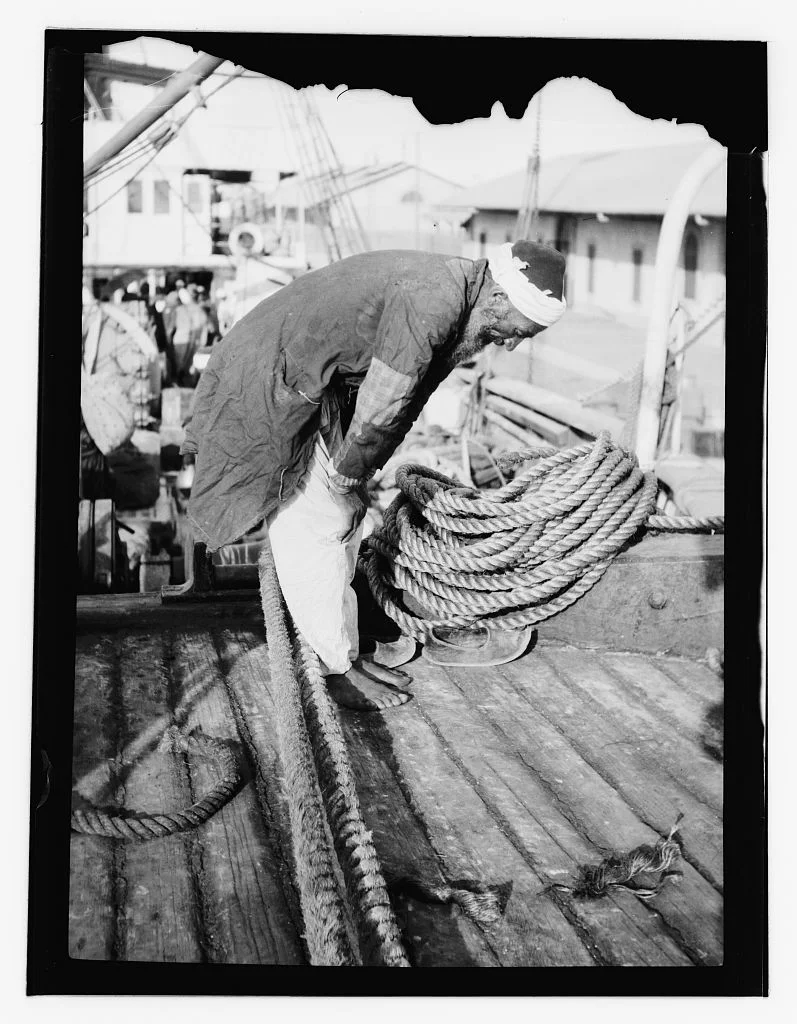
Sinai, man praying/Library of Congress
From Batumi, they continued their journey to Istanbul, passing through various towns and cities. The trip took three days and cost 9 soms and 15 tiyns, excluding food and kudai, which was the money given to the poor. The author notes with some pride that during their week in Istanbul, they learned that the sultan and caliph of all Muslims, Abdul Hamid II, typically visited the Hagia Sophia for Friday prayers. The unknown writer ends the account of his admiration for the city with a heartfelt wish for all Muslims to visit Istanbul.
Later, he appears to have taken four days to get from Alexandria to Yanbui


Caravan of pilgrims crossing a bridge near Suez on their way to Mecca, Egypt, engraving from a photograph by N Corazzini from L'Illustrazione Italiana, year 16, no 4, January 27, 1889/Getty Images
In Medina, the author stayed in a tekke, or a Sufi monastery of dervishes, of one Myrkyi from the Middle Jüz, where he spent twenty-one days. At the end of the nineteenth century, tekkes provided lodgings for pilgrims arriving from Central Asia and other parts of the Russian Empire, and pilgrims often stayed not just a day or two but months and sometimes even years.
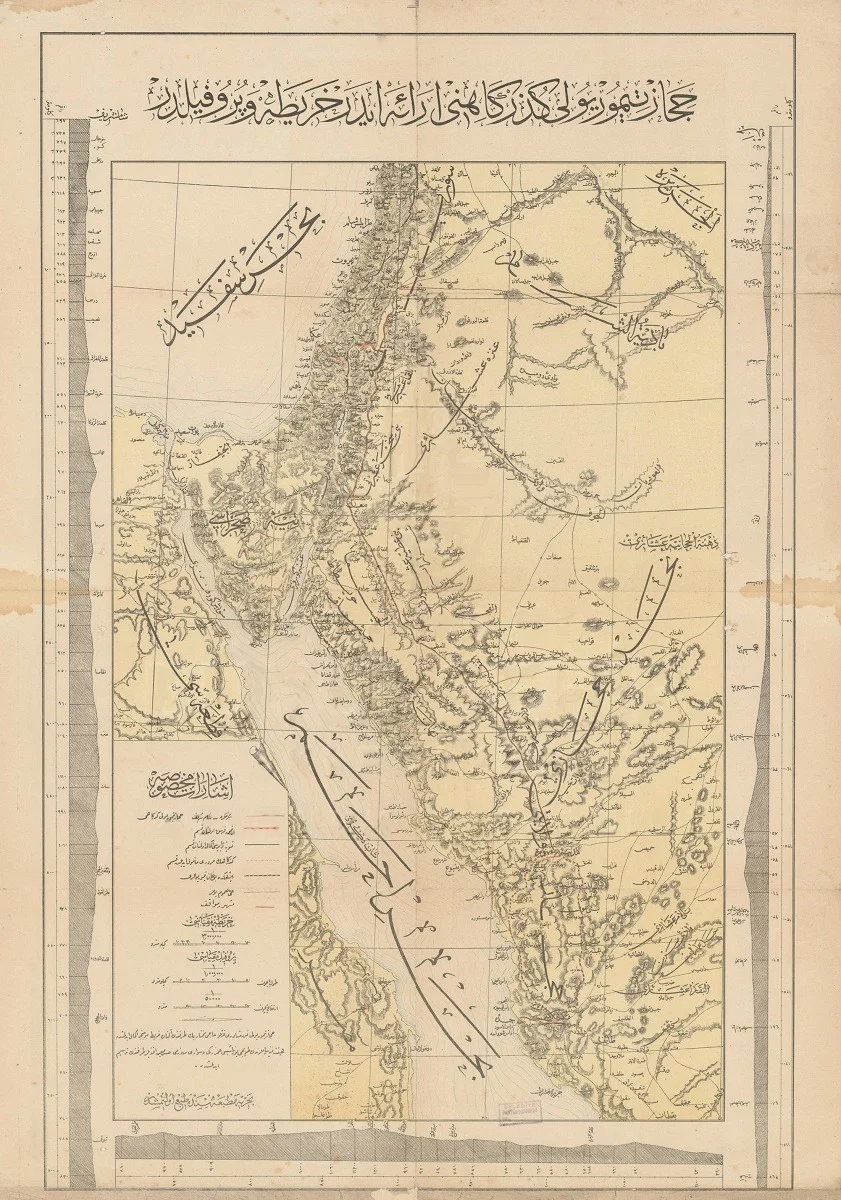
A map of Hejaz Railway in Ottoman Turkish. Early 20th century/Wikimedia Commons
Under the supervision of dalils (hajj guides), they visited various places, the most important of which was the burial place of the Prophet inside the al-Masjid al-Nabawī mosque in Medina. It took them twelve days to reach Mecca on camelback and cost them 11 soms. At the beginning of Dhu al-Hijjahi
The author also mentions a tekke belonging to Kunanbai, the father of Abai. Having performed all the necessary rituals in the Baytullahi
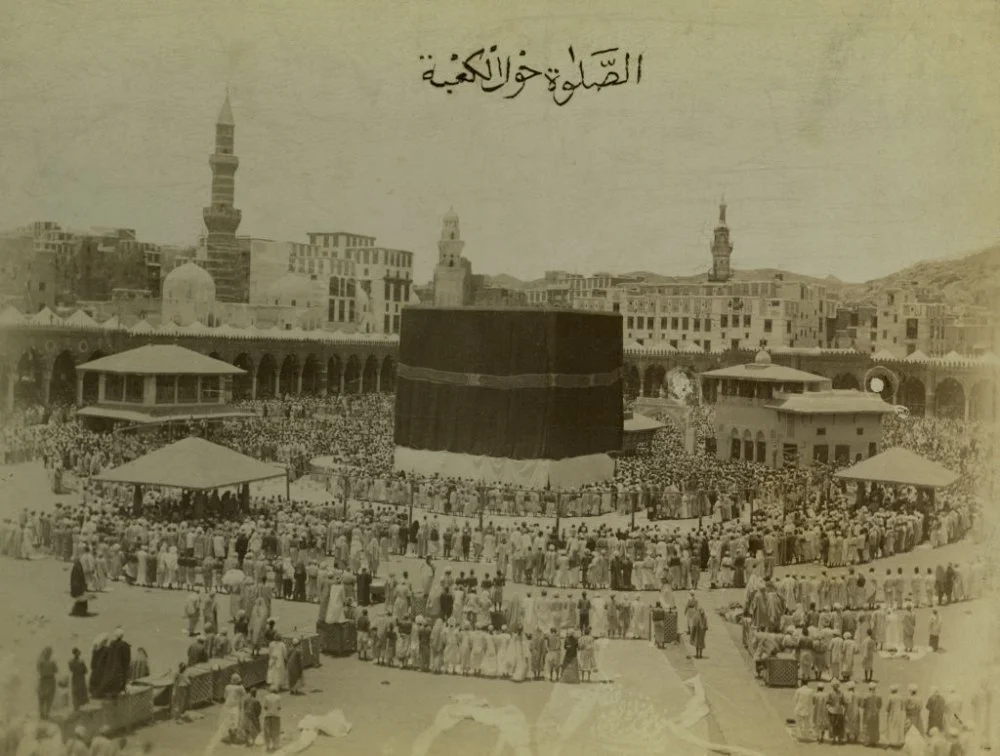
Worshippers attending the prayer around the Kaaba, Mecca, Saudi Arabia, 1901/Photo by Naretti & Davey/Royal Geographical Society via Getty Images
It is worth mentioning that pilgrimages increased the risk of the spread of infectious diseases, such as cholera and plague, which the authorities of many countries feared would spread into Europe. This is why the British government, as well as the governments of other countries, decided to set up a quarantine area for pilgrims from India and Java on Kamaran Island in the Red Sea.
From 1881 to 1893, due to the increased risk of cholera in Hejazi
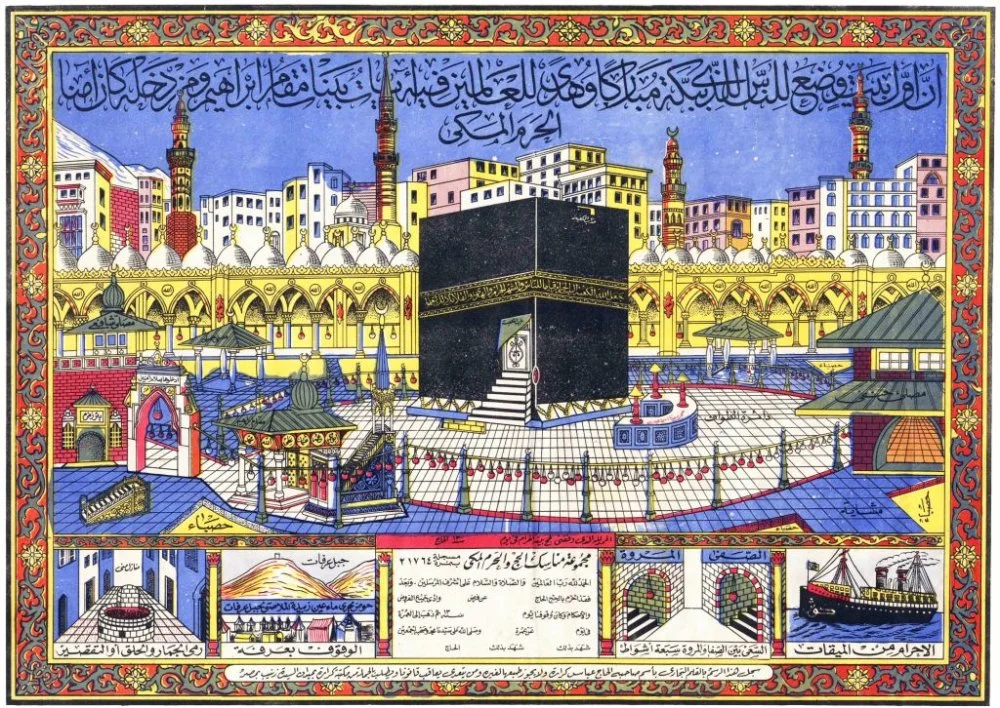
The Masjid al-Haram at Mecca with the Kaaba at its centre, smaller illustrations (left to right) of the well Zamzam, Mount Arafat, Al Safa and Al Marwah, and a pilgrim ship. Coloured woodblock print, c. 1920/Getty Images
In 1893, there was a cholera epidemic that demonstrated how helpless the Ottoman government really was. The press was filled with articles highlighting the lack of basic sanitation in Mecca, and Hejaz became the second biggest epicenter for disease after India.
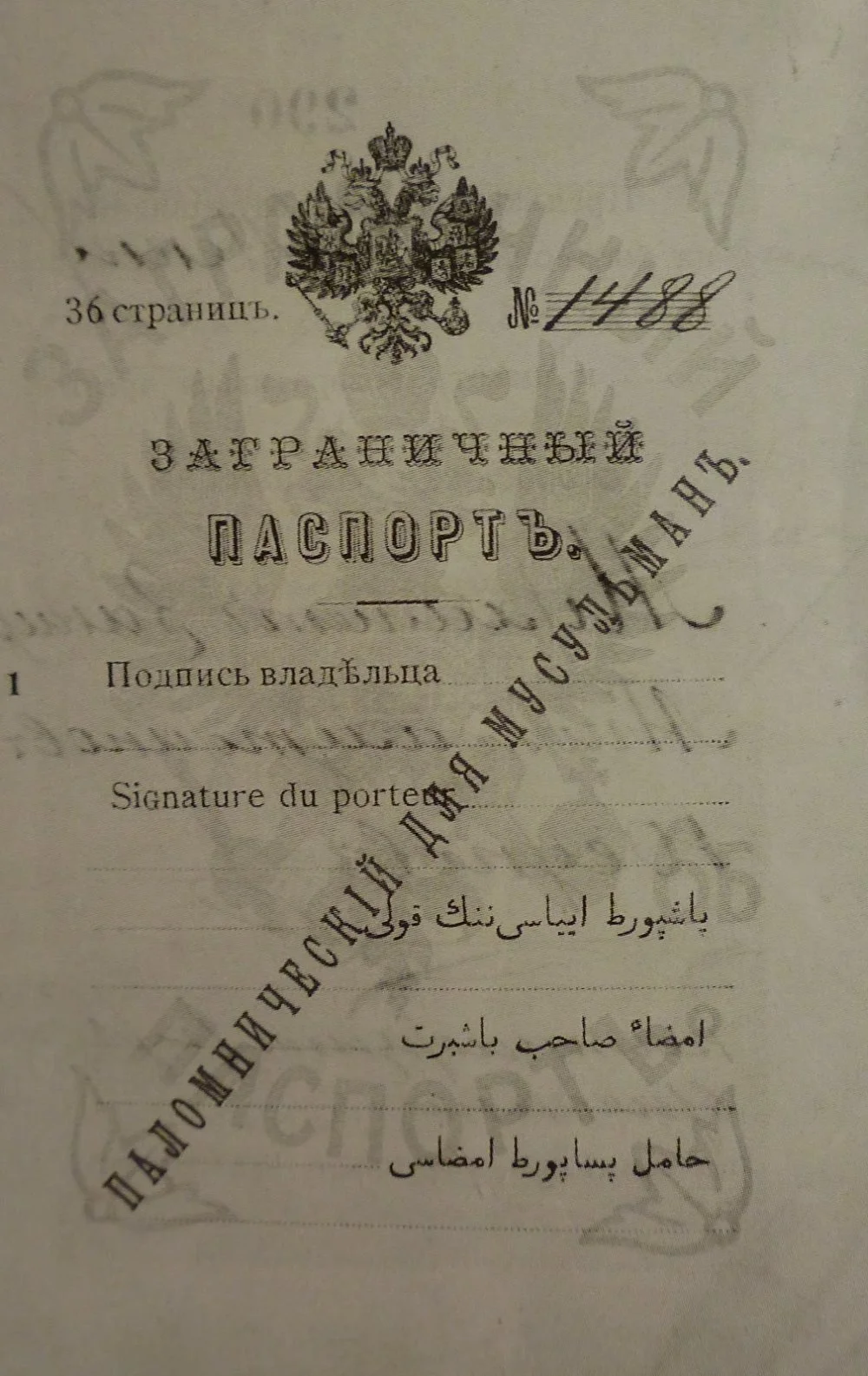
Russian Muslims pilgrim passport of 1903/Wikimedia Commons
During the years of the epidemic, the International Sanitary Council barred pilgrims from the Russian Empire from passing through or stopping on the Ottoman coastline, which triggered different reactions among Muslims. ‘We do not understand the motive that leads the International Council, in this case, not permitting disembarkation or stopping in Turkish ports after the required five to seven days of quarantine,’ wrote the Crimean newspaper Tezhurman.
Thus, many pilgrims from the group of the unknown hajjname author opted to travel by sea to Mumbai, and this trip cost them 4 tillai
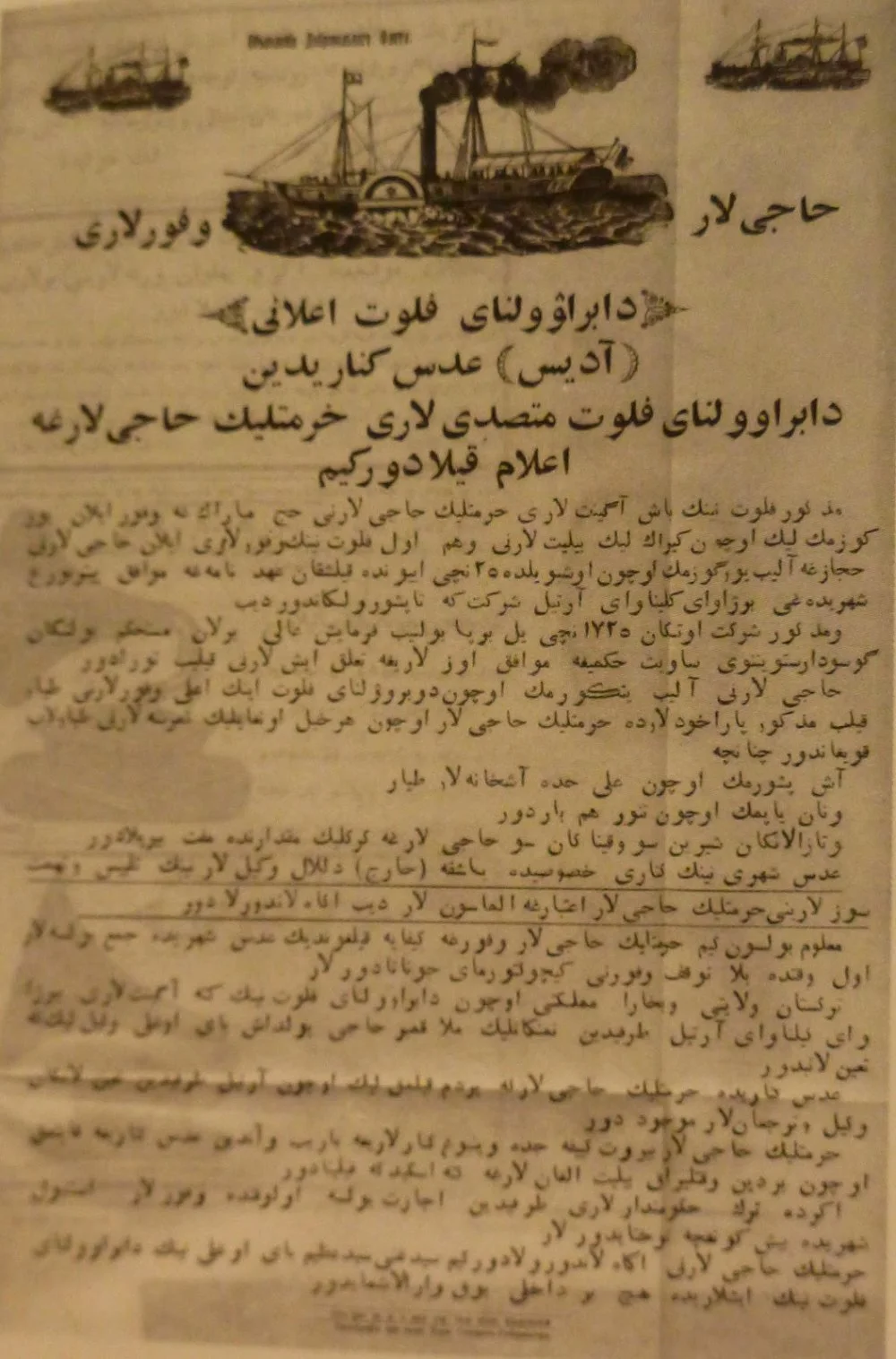
Advertisement for Hejaz Steamships in a Turkestan newspaper. August 19, 1910/Wikimedia Commons
The author recalls that the ruler of the city at that time was Abdur Rahman Khan, and that the city was Muslim. Despite being there alone, they all felt safe among other Muslims. After thirty days, they reached the town of Balha, then the town of Sarabyz, where they crossed the Amu Darya River, finally reaching Kazakh soil. ‘Part of the Amu Darya belongs to the Russians, and the other part to Muslims,’ the author wrote. On their journey to Samarqand, the author noticed that the new road had been built by the Russians. They spent five days in Samarqand, and ten days later, they arrived in Tashkent. After spending thirteen days there, they finally sent a telegram home. Having rented a horse-drawn cart from the Dungans, they reached Almaty after twenty-five days. All in all, their trip to Mecca and back took them fourteen months.

The Sufi Saint Mian Mir Praying at Medina. India 18th century watercolour on paper/Wikimedia Commons
What to read
Кейн А. Российский хадж. Империя и паломничество в Мекку. НЛО, Серия: Historia Rossica: 2021.
Мухтарова Г.Р. Қазақстандағы ислам діні. Қажылық (XIX–XX ғ.басы) Материалдар жинағы. Алматы, Баспалар үйі:2009
Сибгатуллина, А. Контакты тюрок-мусульман Российской и Османской империй на рубеже XIX–XX вв. Москва: Фонд исследований исламской культуры, 2010
Can, L. Spiritual Subjects, Stanford: Stanford University Press, 2020.
Alexandre P., Thomas W., and Thiery Z., eds., Central Asian Pilgrims: Hajj Routes and Pious Visits between Central Asia and the Hijaz. Berlin: Klaus Schwarz Verlag, 2012
Tagliacozzo E. ‘Hajj in the Time of Cholera: Pilgrim Ships and Contagion from Southeast Asia to the Red Sea’ in Global Muslims in the Age of Steam and Print, ed. James L. Gelvin, Nile Green, University of California Press, 2014
